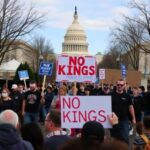Federal unemployment Claims Surge in Virginia: Government Workers Face Uncertainty Amid Policy Shifts
In a stark indicator of brewing economic turbulence, unemployment claims from federal employees in Virginia have spiked by 28% over the past quarter, outpacing the national average and signaling deep ripples from recent government policy changes. This surge, primarily concentrated in the Washington D.C. metro area, underscores the vulnerability of the federal workforce to administrative overhauls, leaving thousands of government workers scrambling for stability in an already volatile job market.
The Virginia Employment Commission reported that Federal unemployment filings reached 4,200 in the third quarter of 2023, up from 3,280 in the same period last year. This escalation comes amid sweeping federal government reforms, including budget reallocations and agency restructurings announced under the current administration, which have led to hiring freezes, early retirements, and outright layoffs across key departments.
For residents in Northern Virginia—home to major federal installations like the Pentagon and CIA headquarters—this isn’t just a statistic; it’s a personal crisis. Long-time government workers, many with decades of service, are now navigating the unfamiliar terrain of job searches outside the secure federal bubble.
Unprecedented Spike Hits Northern Virginia’s Federal Hubs
The epicenter of this Federal unemployment wave is Northern Virginia, where over 60% of the state’s claims originate. Arlington County alone saw a 35% increase in filings from federal workers, according to data from the U.S. Department of Labor. Agencies such as the Department of Defense and the Environmental Protection Agency have been hit hardest, with reports of non-essential positions being eliminated to meet new efficiency mandates.
Take the case of Mark Thompson, a 52-year-old logistics specialist who worked for 25 years at a Defense Department contractor in Fairfax. “One day you’re essential to national security; the next, you’re filing for unemployment,” Thompson shared in an interview. His layoff in August stemmed from a departmental reorganization that consolidated roles, affecting hundreds in similar positions.
Statistics paint a broader picture: The federal workforce in Virginia, which employs over 200,000 people and contributes more than $50 billion annually to the Virginia economy, is contracting at an alarming rate. The Bureau of Labor Statistics notes that while private sector unemployment in the state hovers at 3.2%, federal unemployment claims are pushing the overall rate toward 3.8% in affected regions. This disparity highlights how intertwined the federal presence is with local prosperity, from housing markets in Alexandria to retail in Reston.
Experts attribute the spike to a confluence of factors. “Policy shifts like the recent executive order on federal streamlining have accelerated turnover,” says Dr. Elena Ramirez, an economist at George Mason University. “We’re seeing not just layoffs but a chilling effect—workers are leaving preemptively due to uncertainty.” Ramirez’s research, published in the Journal of Public Economics, predicts that if trends continue, Virginia could lose up to 15,000 federal jobs by mid-2024.
Local unemployment offices are overwhelmed. In Richmond, the state capital, processing times for federal unemployment claims have doubled to 21 days, straining resources designed for a more stable caseload. Government workers, accustomed to robust benefits, are finding the transition jarring; many qualify for extended federal unemployment benefits under the Workforce Innovation and Opportunity Act, but the paperwork is a bureaucratic nightmare.
Policy Overhauls Drive Federal Workforce Disruptions
At the heart of Virginia’s rising federal unemployment lies a series of aggressive policy changes emanating from Washington. The Biden administration’s push for “modernization and equity” in federal operations, coupled with congressional budget cuts totaling $1.2 trillion over the next decade, has forced agencies to rethink their staffing models. In Virginia, this translates to tangible pain: the IRS, for instance, has deferred 5,000 planned hires in Richmond, while the Department of Veterans Affairs in Hampton Roads has seen voluntary separations rise by 40%.
“These aren’t arbitrary cuts; they’re targeted reforms to eliminate redundancies,” explained White House spokesperson Jen Psaki during a recent briefing. However, critics argue the pace is too rapid. Senator Tim Kaine (D-VA), a vocal advocate for federal workers, stated in a floor speech, “Virginia’s economy thrives on a stable federal workforce. Rushing these changes risks not just jobs, but the innovative edge that drives our national security.”
The impacts are multifaceted. Remote work policies, once a lifeline during the pandemic, are being rolled back in favor of in-office mandates, prompting resignations from employees unwilling or unable to commute from as far as Fredericksburg. Additionally, diversity initiatives have led to reshuffling in leadership roles, displacing mid-level managers who now swell unemployment claims.
From a national perspective, Virginia’s situation mirrors broader federal workforce trends. The Office of Personnel Management reports a 12% decline in federal hiring nationwide, but states like Virginia and Maryland—proximal to D.C.—bear the brunt due to their concentration of agencies. A Government Accountability Office audit released last month flagged inefficiencies in transition support, noting that only 45% of displaced workers receive adequate retraining within six months.
Personal stories amplify the human cost. Lisa Chen, a former NOAA analyst in Sterling, filed her unemployment claim after her division was merged into a leaner structure. “I specialized in climate modeling for federal policy—now I’m applying to private consulting firms that don’t value that expertise,” she said. Chen’s experience is echoed by thousands; support groups like the National Treasury Employees Union have reported a 50% uptick in membership inquiries from Virginia chapters.
Economic Ripples Threaten Virginia’s Thriving Local Markets
The surge in federal unemployment is sending shockwaves through the Virginia economy, where government workers form the backbone of consumer spending and real estate. Northern Virginia’s median home price, already inflated by federal proximity, dipped 4% in the last quarter as laid-off employees list properties to relocate or downsize. Realtors in Fairfax report a 20% increase in seller inquiries from federal families.
Small businesses are feeling the pinch too. In Old Town Alexandria, a hub for federal commuters, restaurants and shops have seen foot traffic drop by 15%, per data from the Virginia Restaurant Association. “Our lunch crowd was mostly feds from the Patent Office,” owner Maria Gonzalez lamented. “Now, with hiring freezes, reservations are down, and we’re laying off part-timers.”
Broader economic indicators reflect the strain. The Virginia Economic Development Partnership forecasts a 0.5% drag on statewide GDP growth in 2024 if federal unemployment persists, potentially shaving $2 billion from projected revenues. Unemployment claims processing has also boosted demand for legal and financial services; firms specializing in federal benefits appeals have expanded staff in Richmond and Norfolk.
Yet, not all effects are negative. Some sectors are poised to absorb displaced talent. Tech firms in the Dulles Corridor, home to giants like Amazon Web Services, are ramping up recruitment for cybersecurity roles—areas where federal experience is prized. “We’re hiring former DoD analysts at a premium,” noted recruiter Alex Patel of a Vienna-based staffing agency. Initiatives like the Virginia Works program offer retraining subsidies, helping 1,200 federal workers transition to private sector jobs since July.
Demographic shifts add complexity. Women and minorities, who make up 55% of the federal workforce in Virginia, are disproportionately affected by role consolidations aimed at equity. A study by the Urban Institute reveals that Black government workers in the state face a 32% higher layoff risk, exacerbating income inequality in communities like Prince William County.
State leaders are responding with targeted aid. Governor Glenn Youngkin announced a $10 million fund in September to support federal unemployment claimants, including resume workshops and job fairs co-hosted with federal agencies. “Virginia’s economy is resilient, but we can’t ignore the federal pillar,” Youngkin said at a press conference in Arlington.
Experts Forecast Prolonged Challenges for Federal Stability
Looking ahead, analysts warn that Virginia’s federal unemployment crisis could deepen before it improves. The Congressional Budget Office projects sustained pressure on the federal workforce through 2025, with potential for another 10% reduction in non-defense roles. In Virginia, this means ongoing volatility for the 150,000 civilian federal employees outside the military.
“The real wildcard is the 2024 election,” opined policy analyst Raj Patel of the Brookings Institution. “Further policy shifts could either stabilize or exacerbate the exodus.” Patel’s report estimates that without intervention, unemployment claims could climb to 6,000 quarterly by year’s end, straining the state’s $3.5 billion unemployment insurance fund.
Mitigation efforts are underway at multiple levels. The federal government has expanded the Voluntary Early Retirement Authority (VERA) program, allowing eligible workers to exit with enhanced pensions—over 2,500 Virginians have opted in since June. Meanwhile, bipartisan legislation in Congress aims to streamline reemployment for feds, including tax credits for employers hiring displaced workers.
On the ground, community programs are filling gaps. In Hampton Roads, the Tidewater Workforce Investment Board has launched apprenticeships in shipbuilding, drawing on naval base talent. Success stories like that of former VA employee Jamal Washington, now a project manager at a Norfolk engineering firm, offer hope: “The federal door closed, but private opportunities opened wider.”
As Virginia navigates this federal workforce reckoning, the focus shifts to adaptation. Economists urge diversified growth in sectors like biotech and renewables to buffer against Washington whims. For the thousands filing unemployment claims, the path forward involves resilience, retraining, and a watchful eye on policy horizons. The state’s leaders, from Richmond to the Beltway, must collaborate to safeguard the economic engine that federal workers have long powered.








